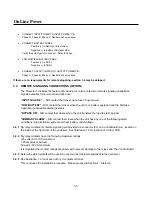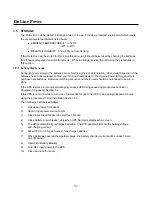
OnLine Power
2-3
2.3.1
Input Contactor K1 (Illustration 2-3, Item 20)
The input contactor is multifunctional. First, it provides connections for the input power to the UPS.
Secondly, the contactor disconnects the input line when an outage occurs so that there is no back feeding
of power into the power line. Finally, the contactor allows for automatic UPS operation upon a complete
discharge of the batteries. No operator intervention is required when power to the UPS is restored after a
complete battery discharge.
2.3.2
Input Transformer (T3) (Illustration 2-2, Item 2)
The input transformer adjusts the input voltage for proper rectifier DC voltage, depending on UPS rated
power and back-up capacity.
2.3.3
Battery Charger (Illustration 2.3, Electronics Tray)
The battery charger maintains the batteries at full charge. After a battery discharge, the charger will
automatically recharge the batteries upon restoration of input power. This circuit is on the Power Board.
2.3.4
Power Board Assembly with IGBT’s (Illustration 2.3, Item 3)
The Power Board is bolted onto the IGBT (
I
nsulated
G
ate
B
ipolar
T
ransistor) blocks that are mounted on a
heat sink. The complete Heat Sink Assembly with IGBTs and Power Board is replaceable as a single part.
This FRU (
F
ield
R
eplaceable
A
ssembly) converts all the power, i.e. input AC power converted to DC bus,
battery power boosted to DC bus, and finally DC bus power converted to output AC power using PWM
technology for a smooth AC sine wave. In case of a catastrophic failure, the complete Heat Sink Assembly
is easily replaceable using only a screwdriver. The Power Board also contains the housekeeping power
supplies and drivers for the IGBTs. The entire assembly provides the landing place for all internal input,
output, DC cables and metering devices for control and monitoring of the unit input and output currents.
2.3.5
Control Board (Illustration 2.2, Item 10)
The microprocessor with unit specific firmware and control circuitry is located on the Control Board. The
Control Board is mounted on the cabinet door and communicates with the Power Board (A2) via a ribbon
cable. It monitors the input and output voltages and generates the command to close or open the input
contactor and to sense and change the status of the bypass static switch. The Control Board sends data to
the LCD panel located on the door where actual status and parameters are displayed. It additionally has
AS400, RS232 and RS485 output capabilities and supports various communication options.
2.3.6
Output Static Switch (Illustration 2.3, Item 18)
This SCR solid-state switch connects the output of the inverter (UPS) to the load. It is connected on the
primary side of the optional output isolation transformer. This switch shuts off in case of a problem or
failure within the UPS and transfers the load directly to the utility input via the bypass static switch. It
maintains its status opposite to that of bypass switch.
2.3.7
LCD Display Panel (Illustration 2.2, Item 11)
The LCD (
L
iquid
C
rystal
D
isplay) panel provides all the input, output, battery metering and alarm data, and
UPS status for customer use on a constantly scrolling set of 2 default screens with continuous update.
Summary of Contents for Protector 3
Page 63: ...OnLine Power 6 24 ...














































